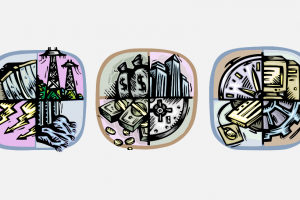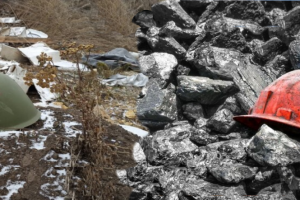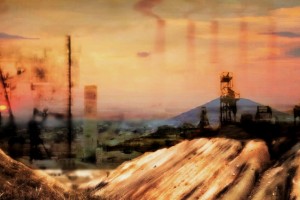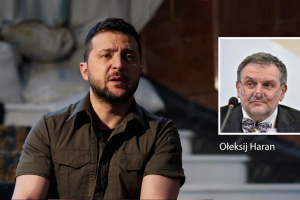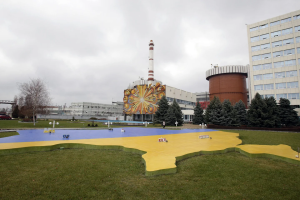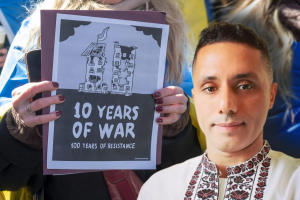Ukrainians reject modern Russia’s WWII victory cult as geopolitical divide deepens
Kyiv's 'Mother of the Motherland' monument decorated with a symbolic wreath of red poppies on May 8, 2015. Since 2015, Ukraine has adopted the poppy as a symbol of WWII memorial events as part of efforts to distance the country from Vladimir Putin's transformation of Victory Day into a celebration of Russian militarism. REUTERS/Gleb Garanich
Source: Atlantic Council
It seems the world is finally waking up to Vladimir Putin’s dangerous exploitation of World War II. In the run-up to this month’s seventy-fifth anniversary of the allied victory over Nazi Germany, international media coverage included a number of reports highlighting modern Russia’s efforts to weaponize the memory of the Second World War. At the same time, relatively few outside observers appear to have noticed the major shifts in memory politics currently taking place inside neighboring Ukraine. Nevertheless, recent research indicates that a majority of Ukrainians now reject many of the core tenets underpinning the Kremlin’s WWII mythology.
These changing Ukrainian attitudes towards WWII deserve a closer look because they offer important insights into the country’s ongoing geopolitical divorce from Putin’s Russia. A separation that began with the 1991 Soviet collapse has been radically accelerated by the past six years of undeclared war. This growing distance between Russia and Ukraine is nowhere more visible than in the two countries’ differing approaches to WWII.
Independent Ukraine was always destined to have a more complicated relationship than neighboring Russia towards the Second World War. As the self-styled successor state of the Soviet Union, modern Russia has been able to directly adopt and significantly expand on Communist-era narratives glorifying the Red Army triumph over Nazism. For post-Soviet Ukraine, things were never so simple. Ukraine’s more nuanced handling of WWII has reflected the broader debate within Ukrainian society over whether the country’s march towards independence in 1991 should be viewed primarily as a liberation movement or a separatist revolt.
During the Communist era, the legacy of the Second World War played a huge role in shaping Soviet identity. However, WWII was not afforded the kind of official preeminence it currently enjoys in today’s Russia. Instead, events to commemorate the defeat of Nazi Germany were traditionally overshadowed by the far greater pomp and pageantry surrounding the anniversary of the 1917 Bolshevik Revolution. Significantly, Victory Day itself only become a public holiday twenty years after the end of the war, while the Soviet authorities staged just four WWII military parades between 1945 and the 1991 collapse of the USSR.
Modern Russia’s Victory Day obsession cannot therefore be viewed as merely a continuation of Soviet veneration. On the contrary, it is very much a twenty-first century innovation. Since the beginning of his reign in 2000, Russian President Vladimir Putin has reinvented Victory Day as the central event on the Russian calendar. Under Putin, the holiday has become an opportunity to celebrate the revival of Russian national pride following the humiliations of the 1990s. Today’s victory cult has rehabilitated the entire Soviet epoch and helped Russians to rationalize the horrors of Stalin’s crimes, while at the same time serving to legitimize Putin’s authoritarian domestic rule and justify the country’s expansionist foreign policy.
Russia’s reinvention of Victory Day has proven particularly problematic in post-Soviet Ukraine. For the first twenty-three years of Ukrainian independence, many chose to eschew the political aspects of the holiday while honoring the staggering sacrifices made by the wartime generation. For many millions of Ukrainians, May 9 remained a deeply emotional day of personal reflection and heartfelt memorials.
However, the political undertones of Victory Day became increasingly impossible to ignore following the start of Russian aggression against Ukraine in 2014. The Soviet wartime experience was central to the information war that accompanied Russia’s attack, with Kremlin propaganda openly deploying the symbolism of WWII and depicting the hybrid conflict against Ukraine as a modern-day extension of the fight against fascism.
Beginning in 2015, Ukrainians have started to officially distance the country from Putin’s Russified version of Victory Day. The calendar of WWII memorials has changed. Ukrainian events now take place on both May 8 and May 9, while the war itself is recognized as beginning in 1939, rather the preferred Russian chronology of 1941-45. Likewise, references to the Soviet Union’s Great Patriotic War have been replaced by the more internationally accepted and politically neutral World War II.
In common with many other allied nations, Ukraine has adopted the poppy as a symbol of memorial. Meanwhile, Russia’s Victory Day symbol, the orange and black St. George’s Ribbon, has been banned. The Kremlin first began actively promoting this ribbon as a Victory Day accessory in 2005, largely in response to the orange ribbons sported by protesters during Ukraine’s winter 2004 Orange Revolution.
Almost a decade later in early 2014, the ribbon would be widely used for identification purposes by Russian-led forces as fighting erupted in eastern Ukraine. This served to transform it into a prominent symbol of Russian imperial aggression in the eyes of many Ukrainians, leading to the introduction of an official ban in 2017.
As Ukraine has developed its own distinctive WWII memorial traditions, public attitudes towards the war have also evolved. A landmark opinion poll conducted on the eve of this year’s seventy-fifth anniversary identified majority Ukrainian support for the move away from Soviet-style interpretations of World War II. This nationwide survey, conducted by the Ilko Kucheriv Democratic Initiatives Foundation in cooperation with the Kyiv International Institute of Sociology, found that 53 percent of respondents backed the 2015 introduction of May 8 as a Day of Remembrance and Reconciliation. Meanwhile, 61 percent opposed the participation of Ukrainian politicians in Russian Victory Day events, including majorities in the traditionally more Kremlin-friendly south and east of the country.
Perhaps the most revealing responses related to the issue of responsibility for the war. 56 percent of Ukrainians agreed with the statement that the Soviet Union, together with Nazi Germany, was responsible for starting World World II, while just 24 percent disagreed. This emphatic result places Ukraine in direct opposition to the Kremlin, which has fought bitterly in recent months against European attempts to hold the USSR accountable for the outbreak of WWII.
The August 1939 Nazi-Soviet Pact is the Achilles Heel of Putin’s attempts to build a modern Russian national identity around a sanitized version of WWII. In recent years, the Kremlin has criminalized references to Nazi-Soviet collaboration, while Putin himself has led Moscow’s often furious responses to international criticism of the Pact. This war of words has escalated significantly over the past six months following the autumn 2019 adoption of a European Parliament resolution blaming the Nazi-Soviet Pact for sparking WWII.
Ukrainian President Volodymyr Zelenskyy has also added his voice to those claiming the Nazis and Soviets must share responsibility for the war. “Poles were the first to feel the consequences of the criminal collusion of the totalitarian regimes. This led to the start of WWII,” he said during a January 2020 visit to Poland to mark the seventy-fifth anniversary of the liberation of Auschwitz death camp. The results of Ukraine’s recent nationwide opinion poll would suggest that Zelenskyy is accurately reflecting the Ukrainian public mood on this issue.
While Ukrainians are increasingly rejecting Russia’s Victory Day orthodoxies, there is little sign of an alternative narrative capable of uniting the nation. The most divisive issue remains attitudes towards the Ukrainian Insurgent Army (UPA) and its role in WWII. The survey found that 44 percent of Ukrainians overall support recognition of UPA forces as fighters for Ukrainian independence, with 22 percent opposed, but the population was more evenly split on the subject in southern and eastern Ukraine.
Differences of opinion are even sharper when the discussion turns from unnamed soldiers to specific personalities, with WWII-era Ukrainian nationalist leader Stepan Bandera serving as perhaps the best example of a figure capable of polarizing Ukrainian public opinion. The other side of this coin is the row over calls to remove Soviet General Nikolai Vatutin’s monument and grave from the park outside the Ukrainian parliament building in central Kyiv. To some, Vatutin is a hero who liberated Kyiv from the Nazis. To others, he is to blame for the deaths of hundreds of thousands of Red Army conscripts during the ill-prepared operation to cross the Dnipro River.
Given the diverse range of competing opinions in today’s Ukraine, no one side can ever hope for a decisive victory in this historical debate. Instead, as Harvard Ukrainian Research Institute director Serhii Plokhy said during a recent Ukrainian Institute discussion on the subject, Ukraine must move beyond a binary approach of victors and villains if it hopes to achieve a sense of closure on the issue of the Second World War.
The search for consensus over Ukraine’s troubled past will likely remain heated for many years to come. WWII is only one aspect of this process, which in turn reflects the wider Ukrainian quest for an independent and inclusive post-Soviet national identity. Ultimately, it is a reminder that the Soviet collapse is still ongoing. The Ukrainian rejection of modern Russia’s victory cult reflects the diverging paths these two formerly intertwined nations now find themselves on, and highlights why Ukraine’s return to the Kremlin orbit has never looked less likely.
Victor Tregubov is a Ukrainian columnist, political activist, and blogger.

